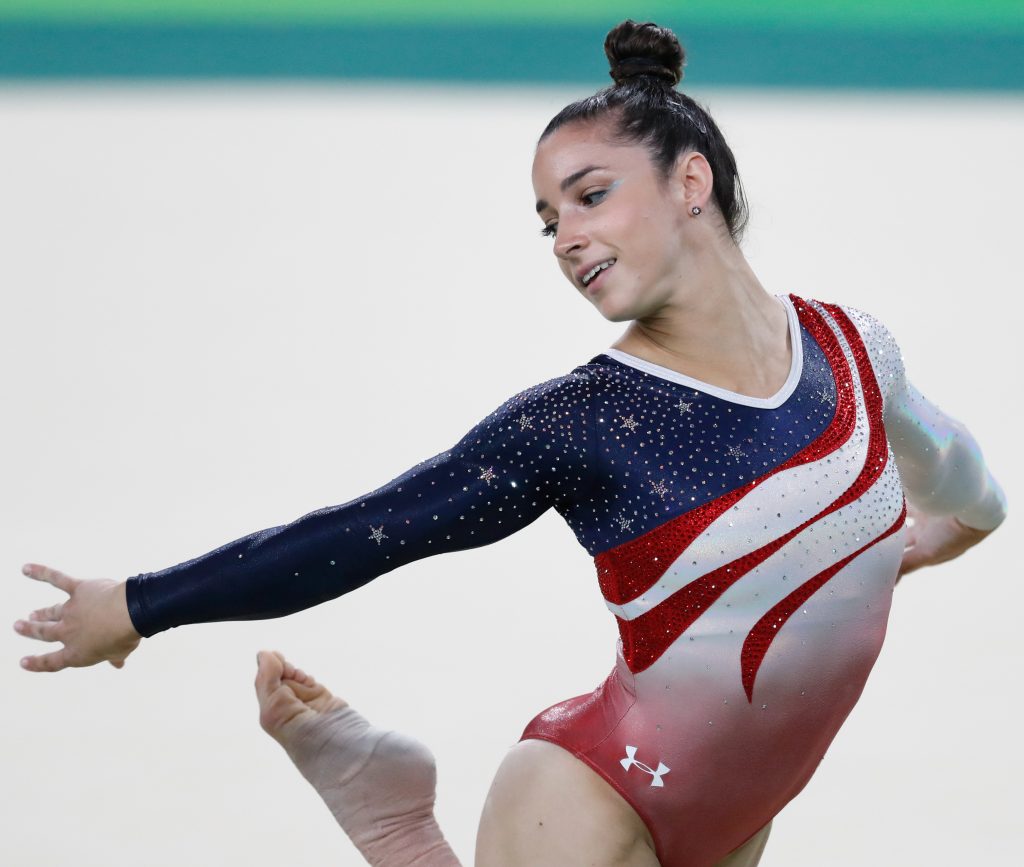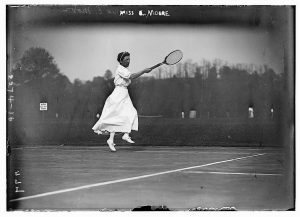Red, White and Sparkle: The Evolution of Team USA’s Olympic Outfits

For gymnasts, a leotard is the equivalent to a red carpet dress at the Oscars. With close to 5,000 crystals on some outfits, when the gymnast steps forward to start a routine, it is as if they are the belle of the ball.

Aly Raisman, captain of USA gymnastics team at Rio 2016, showcases her red, white and blue sparkles on her leotard (Source: Agência Brasil Fotografias / CC BY (https://creativecommons.org/licenses/by/2.0))
Crystals not only look good, but highlight the gymnast’s movements. Spectators can stare at the shining outfits as the gymnast bends, twists, jumps and flips through difficult routines. Yet, it wasn’t always as glamorous.
Once upon a time, leotards were simple, baggy, and covered a woman’s body as much as possible. At the first modern Olympic Games in 1896, athletes even wore their own clothes or private team uniforms.

Elisabeth “Bessie” Holmes Moore, a young tennis champion who won her first U.S. title in 1896. Picture taken c. 1910. (Source: Flickr Commons project and New York Times, 2008)
It was only during the mid-20th century where we saw leotards take the shape we know of today, but Cinderella still had to wait until the 2000s to get her sparkly gown of breathable, streamlined sportswear.
Today, the Olympic lineup can be considered like a fashion runway of athletes outfitted in uniforms by top brands such as Ralph Lauren, H&M, Lacoste and Stella McCartney. In some cases, the uniforms are characterized by high-tech fabric to ensure the absolute best performance.
Designing for athletes can be a challenge. For example, leotards not only need to make the gymnast stand out, but also perform well. It is the ultimate test of creating a garment that needs to be light enough for improved aerodynamics, but incorporate crystals to highlight the athlete’s movements.

Simone Biles, Team USA, performs before winning a gold medal. (Source: Aug. 4, 2016, https://agenciabrasil.ebc.com.br/sites/_agenciabrasil2013/files/fotos/1035024-_mg_1003_04.08.16.jpg – Fernando Frazão/Agência Brasil)
With costs around $1200 per leotard, each athlete has an average of 8 leotards custom-made for their body. GK Elite, the official outfitter of the American national team, even has a department specialized in bejeweling equipment to mass produce nearly any design with crystals in a variety of colors.
Many leotards also combine a fabric called Mystique on top of the spandex to create more shine, and Swarovski are working to make the cut of their crystals even lighter to accommodate demand for bedazzled leotards. In autumn, they are expected to introduce a new crystal product called Concise Crystal that will be 50% lighter than previous stones.
Even leading brands such as Under Armour and Nike are using technologies such as 3D prototyping, smart fabrics and high-tech manufacturing techniques to create apparel that can boost their athletes’ performances. One such product is Nike’s Zoom Superfly Elite, a shoe created using algorithmic software design and 3D printing prototyping, which can shave a runner’s 100-meter-dash time by more than a tenth of a second.
Technology innovation is now as much a part of the athlete’s apparel as training, allowing them to look, feel and perform better. And of course, we can’t forget the impact of those sparkles!

 English
English  French
French  Italian
Italian  Spanish
Spanish 